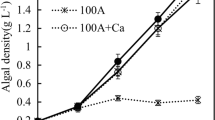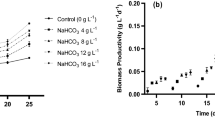Abstract
Using pharmacological and biochemical approaches, Ca2+ involved in the betulin production in mycelia of Phellinus linteus induced by hydrogen sulfide (H2S) were investigated. The results showed that 2 mM H2S donor NaHS or 10 mM CaCl2 was found to enhance the betulin content in the mycelia of Phellinus to the maximum, which were 112.43 and 93.24 % higher than that in the control, respectively. Further, NaHS and CaCl2 co-treatment also showed positive outcome, which were 128.95 or 24.52 % higher than that in the control or NaHS treatment. At the same time, NaHS also enhanced the content of Ca2+ and CaM. But, the above positive inductive effects for Ca2+, CaM, and betulin production can be blocked with either Ca2+ channel blocker (LaCl3, 2-aminoethoxydiphenyl borate) or Ca2+ chelator (ethylenediaminetetraacetic acid (EDTA)). Among of them, betulin content was reduced 35.06 % by NaHS and EGTA to the minimum, and this reduction could be reversed by the application of CaCl2 (NaHS + EGTA + CaCl2). From above results, it can be concluded that endogenous and exogenous calcium involved in the betulin production from submerged culture of P. linteus induced by hydrogen sulfide.







Similar content being viewed by others
References
Elisashvili, V. (2012). Submerged cultivation of medicinal mushrooms: bioprocesses and products. International Journal of Medicinal Mushrooms, 14(3), 211–239.
Zhang, J. M., Zhong, J. J., & Geng, A. N. (2014). Improvement of ganoderic acid production by fermentation of Ganoderma lucidum with cellulase as an elicitor. Process Biochemistry, 49(10), 1580–1586.
Reis, F. S., Barreira, J. C. M., Calhelha, R. C., Griensven, L. J. I. D., Ćirić, A., Glamočlija, J., Soković, M., & Ferreira, I. C. F. R. (2014). Chemical characterization of the medicinal mushroom Phellinus linteus (Berkeley & Curtis) Teng and contribution of different fractions to its bioactivity. LWT–Food Science and Technology, 58(2), 478–485.
Lee, Y. S., Kim, Y. H., Shin, E. K., Kim, D. H., Lim, S. S., Lee, J. Y., & Kim, J. K. (2010). Anti-angiogenic activity of methanol extract of Phellinus linteus and its fractions. Journal of Ethnopharmacology, 131(1), 56–62.
Alakurtti, S., Mäkelä, T., Koskimies, S., & Yli-Kauhaluoma, J. (2006). Pharmacological properties of the ubiquitous natural product betulin. European Journal of Pharmaceutical Sciences, 29(1), 1–13.
Bori, I. D., Hung, H. Y., Qian, K., Chen, C. H., Morris-Natschke, S. L., & Lee, K. H. (2012). Anti-AIDS agents 88. Anti-HIV conjugates of betulin and betulinic acid with AZT prepared via click chemistry. Tetrahedron Letters, 53(15), 1987–1989.
Zhao, F. Q., Mai, Q. Q., Ma, J. H., Xu, M., Wang, X., Cui, T. T., Qiu, F., & Han, G. (2015). Triterpenoids from Inonotus obliquus and their antitumor activities. Fitoterapia, 101, 34–40.
Sun, M. L. (2014). Preliminary study on mechanism of triterpenoids accumulation induced by hydrogen sulfide in Phellinus mycelium. Master thesis, Northeast Forestry University, Harbin, China.
Kabil, O., Vitvitsky, V., & Banerjee, R. (2014). Sulfur as a signaling nutrient through hydrogen sulfide. Annual Review Nutration, 34, 171–205.
Chen, A. W., Zeng, G. M., Chen, G. Q., Zhang, C., Yan, M., Shang, C., Hu, X. J., Lu, L. H., Chen, M., Guo, Z., & Zuo, Y. N. (2014). Hydrogen sulfide alleviates 2, 4-dichlorophenol toxicity and promotes its degradation in Phanerochaete chrysosporium. Chemosphere, 109, 208–212.
Hancock, J. T., & Whiteman, M. (2014). Hydrogen sulfide and cell signaling: team player or referee? Plant Physiology and Biochemistry, 78, 37–42.
Fang, H., Jing, T., Liu, Z., Zhang, L., Jin, Z., & Pei, Y. (2014). Hydrogen sulfide interacts with calcium signaling to enhance the chromium tolerance in Setaria italica. Cell Calcium, 56(6), 472–481.
Christou, A., Manganaris, G. A., Papadopoulos, I., & Fotopoulos, V. (2013). Hydrogen sulfide induces systemic tolerance to salinity and non-ionic osmotic stress in strawberry plants through modification of reactive species biosynthesis and transcriptional regulation of multiple defence pathways. Journal of Experimental Botany, 64(7), 1953–1966.
Dodd, A. N., Kudla, J., & Sanders, D. (2010). The language of calcium signaling. Annual Review of Plant Biology, 61, 593–620.
Tuteja, N., & Mahajan, S. (2007). Calcium signaling network in plants. Plant Signal Behavior, 2(2), 79–85.
Kudla, J., Batistič, O., & Hashimoto, K. (2010). Calcium signals: the lead currency of plant information processing. Plant Cell, 22, 541–563.
Guo, H. B., Zhu, N., Deyholos, M. K., Liu, J., Zhang, X. R., & Dong, J. E. (2015). Calcium mobilization in salicylic acid-induced salvia miltiorrhiza cell cultures and its effect on the accumulation of rosmarinic acid. Applied Biochemistry and Biotechnology, 175, 2689–2702.
Munarona, L., Avanzatoa, D., Mocciad, F., & Mancardie, D. (2013). Hydrogen sulfide as a regulator of calcium channels. Cell Calcium, 53(2), 77–84.
Fan, G. Z., Liu, Y. T., Wang, X. D., & Zhan, Y. G. (2014). Cross-talk of polyamines and nitric oxide in endophytic fungus-induced betulin production in Betula platyphylla plantlets. Trees, 28, 635–641.
Liao, W. B., Zhang, M. L., Huang, G. B., & Yu, J. H. (2012). Ca2+ and CaM are involved in NO- and H2O2-induced adventitious root development in marigold. Journal of Plant Growth Regulation, 31, 253–264.
Wasser, S. P. (2011). Current findings, future trends, and unsolved problems in studies of medicinal mushrooms. Applied Microbiology and Biotechnology, 89, 1323–1332.
Zhua, L. W., Zhong, J. J., & Tang, Y. J. (2008). Significance of fungal elicitors on the production of ganoderic acid and Ganoderma polysaccharides by the submerged culture of medicinal mushroom Ganoderma lucidum. Process Biochemistry, 43(12), 1359–1370.
Xu, Y. N., & Zhong, J. J. (2012). Impacts of calcium signal transduction on the fermentation production of antitumor ganoderic acids by medicinal mushroom Ganoderma lucidum. Biotechnology Advances, 30(6), 1301–1308.
Dörnenburg, H., & Knorr, D. (1995). Strategies for the improvement of secondary metabolite production in plant cell cultures. Enzyme and Microbial Technology, 17(8), 674–684.
Patel, H., & Krishnamurthy, R. (2013). Elicitors inplant tissue culture. Journal of Pharmacognosy and Phytochemistry, 2(2), 60–65.
Lecourieux, D., Ranjeva, R., & Pugin, A. (2006). Calcium in plant defence-signalling pathways. New Phytologist, 171, 249–269.
Martins, T. V., Evans, M. J., Woolfenden, H. C., & Morris, R. J. (2013). Towards the physics of calcium signalling in plants. Plants, 2, 541–588.
Yang, T. B., Peng, H., & Bauchan, G. R. (2014). Functional analysis of tomato calmodulin gene family during fruit development and ripening. Horticulture Research. doi:10.1038/hortres.2014.57.
Wen, R. B., Sui, Z. H., Bao, Z. M., Zhou, W., & Wang, C. Y. (2014). Isolation and characterization of calmodulin gene of Alexandrium catenella (Dinoflagellate) and its performance in cell growth and heat stress. Journal of Ocean University China, 13(2), 290–296.
Acknowledgments
This work was supported by the Fundamental Research Funds for the Central Universities (2572015EA01), the National Natural Science Foundation of China (31100445), and Harbin Technological Innovation Special Fund research projects (2014RFQXJ066).
Author information
Authors and Affiliations
Corresponding author
Additional information
Duan Jian and Meiling Sun contributed equally to this work.
Electronic supplementary material
Below is the link to the electronic supplementary material.
Supplement Table 1
Differential expression genes of terpenoid backbone biosynthesis in Phellinus linteus responsed to H2S treatment (DOC 38 kb)
Supplement Table 2
Differential expression of Ca2+ related genes in Phellinus linteus responded to H2S treatment (DOC 32 kb)
Rights and permissions
About this article
Cite this article
Fan, G., Jian, D., Sun, M. et al. Endogenous and Exogenous Calcium Involved in the Betulin Production from Submerged Culture of Phellinus linteus Induced by Hydrogen Sulfide. Appl Biochem Biotechnol 178, 594–603 (2016). https://doi.org/10.1007/s12010-015-1896-4
Received:
Accepted:
Published:
Issue Date:
DOI: https://doi.org/10.1007/s12010-015-1896-4




